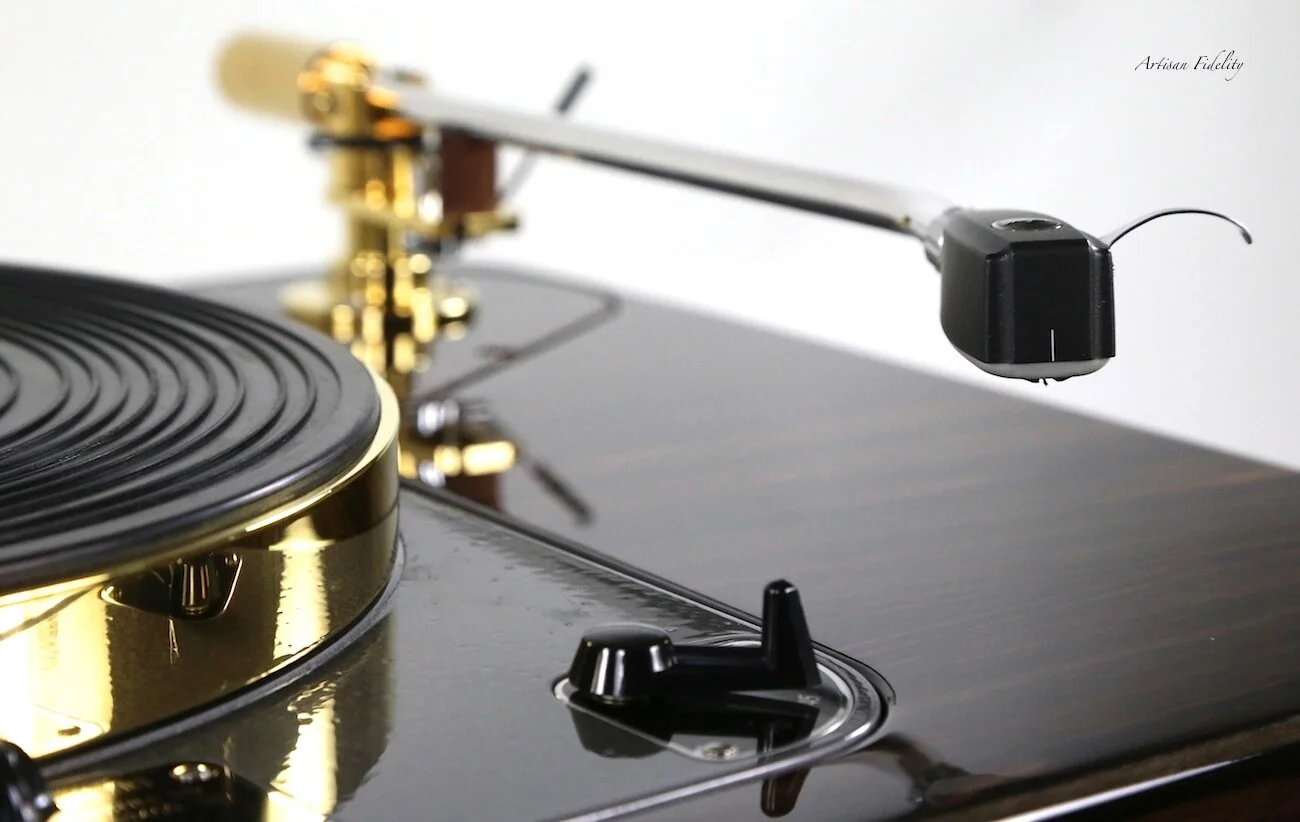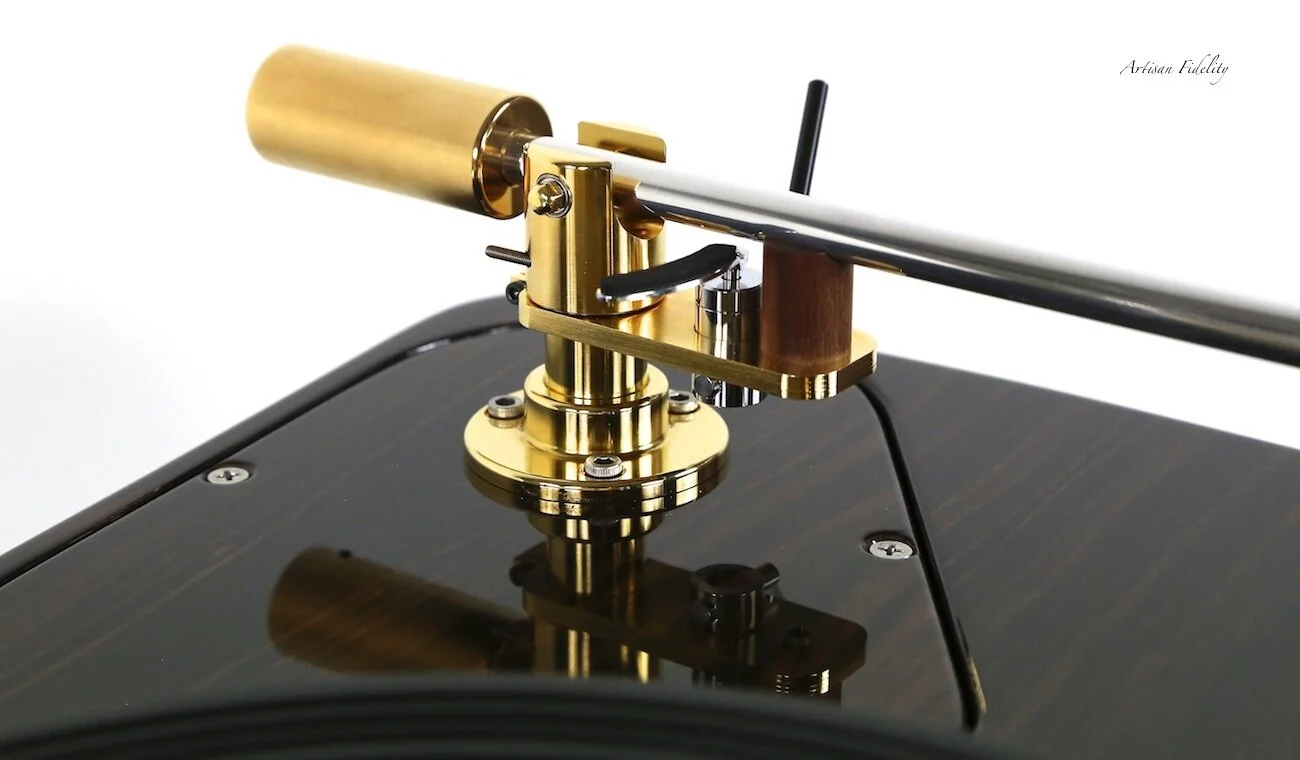Thomas Schick
Thomas Schick
12” Length
This is the classic, long Schick tonearm.
Like all other sizes, my tonearms are available in three coatings:
Gold-plated, shiny
Black chrome, matte
Nickel Palladium, matte
SME or SPU-G, version.
With 5 pin tonearm connector or captive cable.
A tonearm lift and antiskating is of course included.
With regular and / or heavyweight.
As headshell I recommend to use my damped graphite or wood headshell.
Specifications
Finish - Polished Aluminum, Full Black
12 inch tonearm:
Null points : 66 mm and 120,9 mm, Baerwald.
Pivot to spindle distance : 304.75 mm
Offset angle: 17.11°
Overhang: 2.82mm
Effective length: 317.5mm
9” & 10.5” Lengths
Requests kept coming in, so I made a shorter version of my 12 inch tonearm. The differences between them are as ‘small’ as possible because bearings, material, damping, and cabling are identical.
Technically, the shorter arm-tube has advantages, including less resonance and lower moving mass. The geometric distortion rises somewhat, but the effective length of my design’s 9.6 inch arm (longer than most other 9 inch arms) keeps it well below sonic interference or degradation of signal.
The shorter arm has similar sonic characteristics as the longer arm. Additionally, with my graphite head-shell a very large range of suitable cartridges can be used, up to a compliance of 22µm/mN.
Azimuth, VTA (tonearm height) and tracking force can be adjusted as with all my tonearms. This 9.6 tonearm length allows direct mounting on most vinyl players, including plinth designs of HiFi furniture sets.
For those with EMT record players, the mounting distance allows plug-in-replacement without any modification.
Both Schick 9, 10 and our Schick 12 tonearms contain the same parts and go through the same manufacturing process, thus have the same cost.
Specifications
Finish - Polished Aluminum, Full Black
Arm Length
9" – Effective length: 245,8mm
Null points
66, 120,9mm Baerwald
Pivot to spindle distance: 229mm
Offset angle: 22,345°
Overhang: 16,8mm
10.5" – Effective length: 284,4mm
Null points
66, 120,9mm Lofgren A
Pivot to spindle distance: 270mm
Offset angle: 19,182°
Overhang: 14,4mm
Philosophy
Many audiophiles around the world like old 12 inch tonearms from manufacturers such as Ortofon or SME. These arms can produce a nice sound, but the resolution of detail is limited,even with various upgrades. Most of the time the tonearms are in very bad condition, just consider the 40 years of operation.
Loose or worn bearings are the worst prerequisite for good sound and also damage the records and wear the needle faster.
Even in the best condition, the classic bearings leave a lot to be desired. Forty years ago the quality of the bearings was not as good as it is today. In many models, steel balls are simply placed between the tonearm parts.
Even if you think of the rest of the tonearm as mechanically absolutely stable, the bearings are the limiting factor. If the tonearm has play here, all fine details are lost. The needle is supposed to scan all details and act as a generator to convert them into electrical signals. If the structure of the arm works against these finest movements or gives way, the corresponding detail cannot be tracked by the needle or the movement is not correctly converted into an electrical signal. So the play in knife or single point bearings can hardly be a good thing. The advantage here is first of all in the inexpensive production.
The problem with the single point arms is that they tumble around the bearing point. You can dampen this with viscous liquids, but then you have an arm that doesn’t turn particularly easy.
Due to the design, a knife bearing has play. The knife edge wears out quickly and then presents a rough, uneven surface in comparison to the modulations of the plate groove. Even a theoretically smooth knife edge still has upward play and can move accordingly in this direction. A movement that cannot lead to correct tracking.
Ball bearings are very popular in tonearm design and are used quite often. Today, high-tech manufacturing processes allow bearings with very low tolerances. The bearings in the Schick arms have a 0 µm positive tolerance and 7 µm negative tolerance. This means that there may only be a maximum of 7 µm small ‘holes’ in each ball respectively to its race. However, there are many balls in the bearing, so the probability that several deviations form this 7 µm clearance at the same time is very low. This principle results in a connection that is practically free of play. Leaving enough ‘air’ of course to rotate freely.
This low tolerance has other properties that are advantageous when building the tonearm: Low running noise. Running noises are undesirable. In the form of resonances, they also contribute to the loss of information. The low tolerance of the polished raceways and balls as well as a synthetic lubricant ensure the lowest possible running noise. It is possible to buy bearings that look very similar for a small price, but the low quality can be heard directly. When turned close to the ear, cheap bearings generate noise. You can hear the metallic crunching noises of a brand-new, perfect bearings! Nothing you want in the sound of your turntable system.
For example, turn the vertical axisof an old tonearm and you’ll know what I’m talking about.
Low tolerance and a smooth surface have another advantage. A low breakaway torque.
The mechanical force to set the bearing in motion at all is very low, so the pickup can better. The extremely smooth surface also keeps rolling friction very low, not least thanks to the special synthetic lubricant. A normal ball bearing grease would act like glue here.
One more word about durability. These bearings are specified for extremely high speeds, something that is not found in tonearm life, but this guarantees an extremely long life of several decades.
Material selection
Apart from the movable axes of the tonearm, the choice of material also plays an important role. Metal is a good resonator, which is bad at first. But metal parts that are mechanically connected to each other hardly resonate anymore. In Schick tonearms, the headshell construction takes over this function, among other things. The contact area between the arm and the headshell plug very effectively reduces the resonance. The same goes for the axis through the arm and the counterweight. All elements are connected to one another to reduce resonance.
Special attention was paid to the damping of the tonearm tube. Here 3 different materials in 9 sections are used to optimize the resonance behavior. Optimal does not mean absolute ‘dead’ (overdamping), but rather using it in the right place, in the right amount.
Conclusion
Although these factors are theoretically known, in reality they are not applied to most tonearms on the market. If so, you can find them in, let’s say, not exactly cheap tonearms. Many new tonearm designs also do not allow the use of heavy cartridges.
Against the trend towards mass-produced goods, outsourcing and production in low-cost countries, my tonearms are completely handmade in Germany.
I would be happy to make one for you too.






